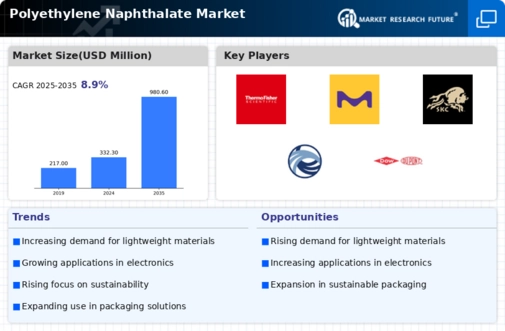Market Analysis
In-depth Analysis of Polyethylene Naphthalate Market Industry Landscape
Polyethylene Naphthalate (PEN) is a high-performance engineering plastic that has gained significant traction in various industries due to its excellent mechanical properties, thermal stability, and chemical resistance. The market dynamics of PEN are influenced by several factors, including demand drivers, supply-side factors, technological advancements, regulatory policies, and competitive landscape.
The increasing use of polyethylene naphthalate in food packaging is expected to propel the market growth during the review period due to its high durability
One of the primary drivers of the PEN market is the increasing demand for lightweight and durable materials in various end-use industries such as packaging, automotive, electronics, and textiles. PEN's superior mechanical strength, high heat resistance, and barrier properties make it an ideal choice for applications where performance and reliability are critical. Additionally, the growing emphasis on sustainability and recyclability has led to the adoption of PEN as a substitute for traditional materials like glass and metal, further fueling its demand.
On the supply side, the availability of raw materials, primarily naphthalene and ethylene glycol, plays a crucial role in determining the market dynamics of PEN. Fluctuations in the prices of these raw materials, driven by factors such as feedstock availability, geopolitical tensions, and currency exchange rates, can impact the production costs of PEN and ultimately influence its market price and competitiveness. Additionally, technological advancements in manufacturing processes, such as improved catalysts and reaction conditions, have enabled producers to enhance the efficiency and cost-effectiveness of PEN production, thereby shaping market dynamics.
Regulatory policies and environmental concerns also exert a significant influence on the PEN market. As governments worldwide impose stricter regulations on the use of plastics and promote sustainable alternatives, manufacturers are increasingly focusing on developing eco-friendly formulations of PEN that are biodegradable or recyclable. Moreover, initiatives aimed at reducing carbon emissions and promoting circular economy principles are driving innovation in PEN recycling technologies, thereby creating new opportunities and challenges for market players.
The competitive landscape of the PEN market is characterized by the presence of a few key players dominating the global market share. These companies invest heavily in research and development activities to enhance product performance, expand their product portfolios, and gain a competitive edge. Strategic partnerships, mergers, and acquisitions are also common in the PEN industry as companies seek to strengthen their market position and capitalize on emerging opportunities.
Market dynamics of PEN are also influenced by macroeconomic factors such as economic growth, consumer purchasing power, and industrialization trends. For instance, robust economic growth in emerging markets drives demand for PEN-based products in sectors such as automotive and consumer electronics, while economic downturns or recessions may lead to temporary slowdowns in demand.








Leave a Comment